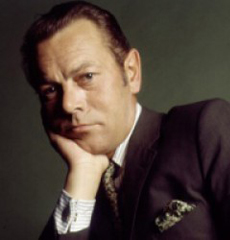
"I want to make music for everyone. It must be enjoyed by all. Otherwise it is pointless."
Includes four bonus tracks: Easy Glider, Jumpin' Blue, Walkin' And Shoutin' and Soul Time.
Sound Engineer: Peter Klemt
Concept & Text: Bert Kaempfert Music, Hamburg
Translation: Angela Schumacher
Design: LOGICON HAMBURG
Polydor 533 908-2 (deleted)
Biography
Bert Kaempfert's great breakthrough came in 1960 with his No. 1 hit in the USA, Wonderland By Night, which went on to conquer the world. He was the first German bandleader to be awarded a gold record in the USA. DJs in the American music magazine Cash Box voted his orchestra "Band of the Future."
In 1968 Bert Kaempfert won no less than five of the annual BMI awards in New York in the category of "most played compositions" for Lady, Spanish Eyes, Strangers In The Night, Sweet Maria and The World We Knew.
In 1974 "Mr. Invisible" received triumphant applause at his first two live concerts in London's Royal Albert Hall. At the early age of 56, Bert Kaempfert died of a stroke on 21 June 1980. That his music and compositions have a firm place in international music life is emphasized by numerous posthumous awards. In June 1993 he was elected to "The Songwriters' Hall of Fame" in New York - the first German to receive this most prestigious of all international awards.
Swing
Like many musicians of his generation, Bert Kaempfert had a foible for swing. In October 1977 he fulfilled a long-cherished wish and recorded a complete album with 12 titles taken from the repertoire of the most famous swing bands. He breathed new life into these old favorites without detracting from their typical and highly unique original sound. Renowned soloists, all of whom were regular members of his orchestra as from the 1970s, performed the solos in this production:
Ack van Rooyen (trumpet and cornet), Herb Geller (flute and alto saxophone), Ferdinand Powel (tenor saxophone), James Towsey (baritone saxophone) and Jiggs Whigham (trombone).
Although Bert Kaempfert preserves the original tempo in his arrangement of Woody Herman's Woodchopper's Ball (original recording: 12 April 1939), his personal stroke of the pen is discernable in every other respect. Herman's clarinet solo is played here by Ack van Rooyen. Trombone, baritone sax and further trumpet solos follow before the well-known riffs are heard to conclude the piece.
If ever a research poll were carried out to determine the most popular post-war number, Glenn Miller's recording of In The Mood (original recording 1 August 1939) would surely come out on top. Realizing that nothing could possible improve this classic work, Kaempfert arranged the piece in a traditional manner.
Over the years, Bert Kaempfert did not only chose the one or the other swing tile for inclusion in his LP recordings but also wrote swing numbers himself which justifiably take their place among the classics. Four of these compositions are included in the present re-release as bonus tracks: Easy Glider and Jumpin' Blue, both recorded in 1974, Walkin' And Shoutin' from 1975, and Soul Time from 1968.
It was Stan Kenton who effected the break with the tradition of swing and ushered in the era of orchestral jazz. Those who never really felt comfortable with Kenton's recording of Intermission Riff (original recording: July 1946) will very probably enjoy Bert Kaempfert's milder version.
Jumpin' At The Woodside is a further number by Count Basie (original recording: 22 August 1938) which has always been a great favorite with the public thanks to its hypnotic riffs. Kaempfert takes the pace more slowly in his arrangement, while the solo flute, muted trumpet and trombone provide for plenty of variety.
Like numerous other numbers by Tommy Dorsey, Marie also landed in the charts in the early 1940s (original recording: 17 October 1940). Kaempfert takes the tempo somewhat more slowly and gives prominence to the trombone - clearly a tribute to the great trombonist Dorsey and his velvety sound.
In It's Only A Paper Moon (original recording: December 1943 by the Nat "King" Cole Trio), Bert Kaempfert does not base his arrangement on any one particular version but concerns himself more with the title itself which was a tremendous hit in post-war years.